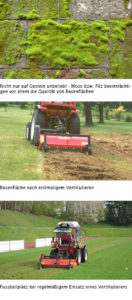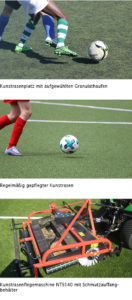AGRITEC machines mean wellness for your green spaces. Whether for real or artificial turf, professional maintenance should not be neglected for long-term pleasure.
Scarifying
 Why scarify? Lawn grasses, like all perennial plants, go through a vegetation cycle. That means that they germinate, form new shoots and die back in parts. The dead plant parts fall to the ground and, together with cut material that isn’t picked up, form a thin layer of organic material. Together with moss and flat-growing weeds, they gradually form a network, the so-called spongy layer, across the entire surface of the lawn. Microorganisms normally ensure that the spongy layer is broken down again. But if the layer becomes ever thicker over the course of time, then the microorganisms can no longer do their work. Moss and weeds grow vigorously. As a result, the lawn grasses no longer get enough light, oxygen and nutrients owing to the spongy layer “infestation”. The grass becomes scarce, yellow and meagre. What does a scarifier do? The AGRITEC scarifier ST40 is adjusted to the ideal working depth of 2-3 mm without tools by means of a central spindle, this enables the scarifier blades, made of unbreakable spring steel, to scrape and score the turf vertically. In order avoid obstacles without a problem, the 2 blades are freely suspended. An optimum result is achieved with a slot distance of 2 cm. The blade shaft in the ST40, which turns against the direction of travel, eliminates the moss and spongy material layer which has formed from the dead plant parts. Furthermore, the roots growing in the width can be separated by the blades during the scarifying process. When should you scarify? The ideal time for scarifying is in spring, since the grass has good capacity for regeneration in this season. However, this measure is also possible until the middle of autumn. In general, scarifying should be done on a mowed lawn (2-3 cm). Summary: After this measure, light and water can be absorbed more easily and in a sufficient form. As a result, the grass roots get more oxygen, the grass becomes denser and ultimately more hard-wearing. Tip: In order to prevent the lawn becoming matted again, it is always advisable to remove the debris from scarifying. Moss which is removed is particularly good for use as a water-retaining mulch material for vegetable beds or as a loosening addition to balcony flower soil which you are mixing yourself.
Why scarify? Lawn grasses, like all perennial plants, go through a vegetation cycle. That means that they germinate, form new shoots and die back in parts. The dead plant parts fall to the ground and, together with cut material that isn’t picked up, form a thin layer of organic material. Together with moss and flat-growing weeds, they gradually form a network, the so-called spongy layer, across the entire surface of the lawn. Microorganisms normally ensure that the spongy layer is broken down again. But if the layer becomes ever thicker over the course of time, then the microorganisms can no longer do their work. Moss and weeds grow vigorously. As a result, the lawn grasses no longer get enough light, oxygen and nutrients owing to the spongy layer “infestation”. The grass becomes scarce, yellow and meagre. What does a scarifier do? The AGRITEC scarifier ST40 is adjusted to the ideal working depth of 2-3 mm without tools by means of a central spindle, this enables the scarifier blades, made of unbreakable spring steel, to scrape and score the turf vertically. In order avoid obstacles without a problem, the 2 blades are freely suspended. An optimum result is achieved with a slot distance of 2 cm. The blade shaft in the ST40, which turns against the direction of travel, eliminates the moss and spongy material layer which has formed from the dead plant parts. Furthermore, the roots growing in the width can be separated by the blades during the scarifying process. When should you scarify? The ideal time for scarifying is in spring, since the grass has good capacity for regeneration in this season. However, this measure is also possible until the middle of autumn. In general, scarifying should be done on a mowed lawn (2-3 cm). Summary: After this measure, light and water can be absorbed more easily and in a sufficient form. As a result, the grass roots get more oxygen, the grass becomes denser and ultimately more hard-wearing. Tip: In order to prevent the lawn becoming matted again, it is always advisable to remove the debris from scarifying. Moss which is removed is particularly good for use as a water-retaining mulch material for vegetable beds or as a loosening addition to balcony flower soil which you are mixing yourself.
Attachments
Maintenance
 Why should artificial turf be maintained? Despite their greater robustness and resistance compared to natural grass pitches, artificial turf pitches also suffer from overuse of the grass and are of course also subject to meteorological influences. The high frequency of use owing to the robustness result in artificial turf pitches being overused and the ball bounce and ball rolling characteristics get worse. The causes of this are accumulation of the filling material and bending of the artificial blades, as well as contamination with leaves, waste, etc. In addition, environmental effects have a negative impact of the durability of the artificial turf. If the surfaces are clogged with dirt and other impurities, the result is poor water permeability. As on natural turf, moss and weeds grow on the damp surface and the playability of the turf declines further. In the worst case, the occurrence of injuries increases owing to the increased risk of slipping and the contaminations. What does an artificial turf maintenance machine do? There are various designs of artificial turf maintenance machines which are used depending on the strain on the turf. Two functions are essential: Levelling of filling material such as sand, rubber or plastic granulate and straightening of the turf fibres. On the one hand, this restores the evenness of the turf, i.e. ball bounce and ball characteristics are more predictable/constant – on the other hand, the improved permeability to water increases the durability. Professional systems such as the NTS140 from Agritec have still more benefits. Among other things, they can pick up the filling material instead of just spreading new material. They screen out the coarse dirt and fill it back in. The water permeability and quality of the turf are thus ensured in the long term. How often should artificial turf maintenance be carried out? Regular maintenance is essential if you are interested in consistent playing properties and durability. The intervals should be determined based on the strain, environmental factors and the type of artificial turf. Tip: We are happy to demonstrate our maintenance machines at your facility so that you can decide for yourself which model is most suitable for you.
Why should artificial turf be maintained? Despite their greater robustness and resistance compared to natural grass pitches, artificial turf pitches also suffer from overuse of the grass and are of course also subject to meteorological influences. The high frequency of use owing to the robustness result in artificial turf pitches being overused and the ball bounce and ball rolling characteristics get worse. The causes of this are accumulation of the filling material and bending of the artificial blades, as well as contamination with leaves, waste, etc. In addition, environmental effects have a negative impact of the durability of the artificial turf. If the surfaces are clogged with dirt and other impurities, the result is poor water permeability. As on natural turf, moss and weeds grow on the damp surface and the playability of the turf declines further. In the worst case, the occurrence of injuries increases owing to the increased risk of slipping and the contaminations. What does an artificial turf maintenance machine do? There are various designs of artificial turf maintenance machines which are used depending on the strain on the turf. Two functions are essential: Levelling of filling material such as sand, rubber or plastic granulate and straightening of the turf fibres. On the one hand, this restores the evenness of the turf, i.e. ball bounce and ball characteristics are more predictable/constant – on the other hand, the improved permeability to water increases the durability. Professional systems such as the NTS140 from Agritec have still more benefits. Among other things, they can pick up the filling material instead of just spreading new material. They screen out the coarse dirt and fill it back in. The water permeability and quality of the turf are thus ensured in the long term. How often should artificial turf maintenance be carried out? Regular maintenance is essential if you are interested in consistent playing properties and durability. The intervals should be determined based on the strain, environmental factors and the type of artificial turf. Tip: We are happy to demonstrate our maintenance machines at your facility so that you can decide for yourself which model is most suitable for you.









